
Prairie du Chien is a city in and the county seat of Crawford County, Wisconsin, United States. The population was 5,506 at the 2020 census. Often called Wisconsin's second-oldest city, Prairie du Chien was established as a European settlement by French voyageurs in the late 17th century. Its settlement date of June 17, 1673, makes it the fourth colonial settlement by European settlers in the Midwestern United States, after Green Bay, Wisconsin, Sault Ste. Marie, Michigan, and St. Ignace, Michigan. The city has many sites showing its rich history in the region.

Fort Crawford was an outpost of the United States Army located in Prairie du Chien, Wisconsin, during the 19th century.
The history of Wisconsin encompasses the story not only of the people who have lived in Wisconsin since it became a state of the U.S., but also that of the Native American tribes who made their homeland in Wisconsin, the French and British colonists who were the first Europeans to live there, and the American settlers who lived in Wisconsin when it was a territory.
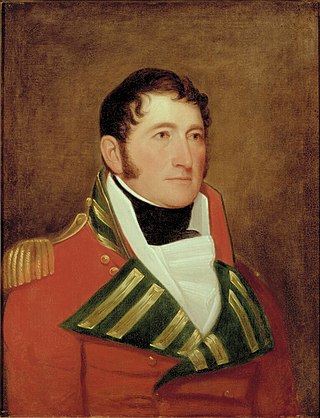
Lt.-Colonel William McKay is remembered for leading the Canadian Forces to victory at the Siege of Prairie du Chien during the War of 1812. After the war, he was appointed Superintendent of Indian Affairs at Drummond Island in what was then Upper Canada. Previous to the war, McKay was a noted fur trader who had travelled widely in Canada. He was a partner of the North West Company and a member of the Beaver Club at Montreal, Quebec. He was a brother of Alexander McKay, who accompanied Sir Alexander Mackenzie to the Pacific Ocean in 1793.
Major-General Robert McDouall, CB was a Scottish-born officer in the British Army, who saw much action during the Napoleonic Wars and the Anglo-American War of 1812. He is best known for serving as the commandant of Fort Mackinac from 1814 until the end of the War of 1812.
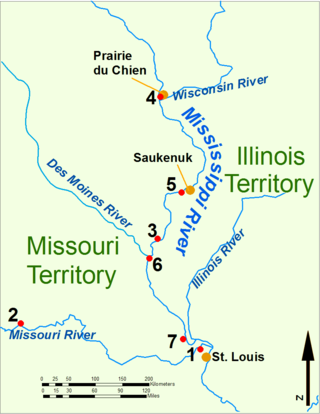
During the War of 1812, the Illinois Territory was the scene of fighting between Native Americans and United States soldiers and settlers. The Illinois Territory at that time included the areas of modern Illinois, Wisconsin and parts of Minnesota and Michigan.

The Battle of Mackinac Island was a British victory in the War of 1812. Before the war, Fort Mackinac had been an important American trading post in the straits between Lake Michigan and Lake Huron. It was important for its influence and control over the Native American tribes in the area, which was sometimes referred to in historical documents as "Michilimackinac".

Fort Howard was a 19th-century fortification in the north central United States, built by the U.S. Army. It was located along the west bank of the Fox River in Green Bay, Wisconsin.

Red Bird was a leader of the Winnebago Native American tribe. He was a leader in the Winnebago War of 1827 against Americans in the United States making intrusions into tribal lands for mining. He was for many years one of the most friendly and trusted of the Wisconsin Native Americans. In the late 1820s Red Bird and his followers began to grow uneasy over the encroachments of lead miners on Ho-Chunk land. The tribe had an uneasy relationship with the dominant culture's legal concepts and often continued to follow tribal practices of justice. This tension resulted in several incidents, including confrontations with Secretary of War, John C. Calhoun. One incident involved the mistaken information channeled to the tribe that two Ho-Chunk executions were conducted at Fort Snelling in 1826 for a murder they did not commit. As white miners continued to extract resources near Winnebago villages on the Rock River, the War Department sought to keep tribes from mining the same minerals, in fear that the land would become contentious. Near Prairie du Chien on June 28, 1827, Red Bird had become increasingly angered by treatment of the tribe. Encroachment on native lands, unfair incarceration, and increasing violence led to escalating tensions. Under pressure from the tribe to defend their interests, Red Bird set off with two others, Chickhonsic and Wekau ; eventually meeting a trader, John Lockwood and a former British soldier, Duncan Graham, who advised against violence. Upon arriving at the cabin of Registre Gagnier, the party was met with a friendly welcome and invited in for refreshment. Gagnier, feeling suspicious about the nature of the visit, reached for his rifle, thus setting off the following events. Chickhonsic shot Solomon Lipcap. Wekau attempted to shoot Mrs. Gagnier, but she and her son escaped and gave the alarm in Prairie du Chien.

The Villa Louis is a National Historic Landmark located on St. Feriole Island, in Prairie du Chien, southwestern Wisconsin. The villa and estate are a historical museum operated by the Wisconsin Historical Society. The site has been restored to its appearance during the late 19th century, when it was the estate of the prominent H. Louis Dousman family, descendants of a fur trader and entrepreneur.
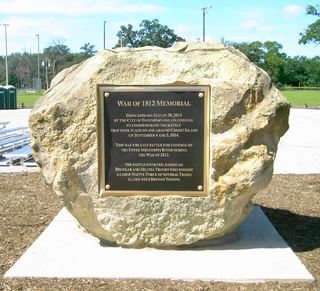
Credit Island is an island in the Mississippi River on the south west side of Davenport, Iowa within the Quad Cities area. Its name was derived by the use of the island as an early Indian trading post. Credit could be obtained on the promise of hides and skins to be delivered at a later time, hence the name. It was listed on the Davenport Register of Historic Properties on February 3, 1999.

The Battle of Prairie du Chien was a British victory in the far western theater of the War of 1812. During the war, Prairie du Chien was a small frontier settlement with residents loyal to both American and British causes. By 1814, both nations were anxious to control the site because of its importance to the fur trade and its strategic location at the intersection of the Mississippi River and the Fox-Wisconsin Waterway, a transportation route linking the Mississippi with the Great Lakes.
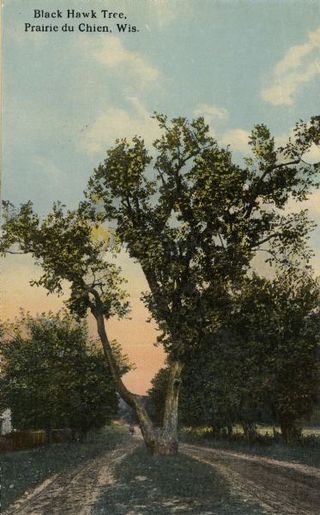
The Black Hawk Tree, or Black Hawk's Tree, was a cottonwood tree located in Prairie du Chien, Wisconsin, United States. Local legend held that Sauk leader Black Hawk used it to elude his pursuers, though there are differing details and versions of the story. One version puts Black Hawk's presence in the tree during the 1790s, while another states it was after the conclusion of the 1832 Black Hawk War and involved a young Lieutenant Jefferson Davis. In reality, it is unlikely that Black Hawk ever used the tree to hide, though he was probably in Prairie du Chien once after his surrender at the end of the 1832 Black Hawk War. The tree was felled by a windstorm during the 1920s.
Bernard Walter Brisbois was an agent for the American Fur Company.

Campbell's Island is an island and unincorporated community in the Mississippi River. The island is located in Hampton Township, Rock Island County, Illinois. It is adjacent to the city of East Moline and is connected to the city by a bridge. It is the site of the Campbell's Island State Memorial, a listed historic site overseen by the Illinois Historic Preservation Agency.
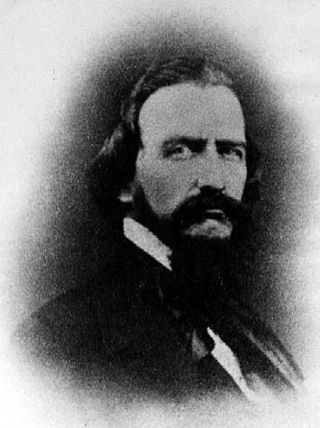
Nicholas Boilvin was a 19th-century American frontiersman, fur trader, and U.S. Indian Agent. He was the first appointed agent to the Winnebagos, as well as the Sauk and Fox, and one of the earliest pioneers to settle in present-day Prairie du Chien, Wisconsin. His sons Nicholas Boilvin, Jr. and William C. Boilvin both became successful businessmen in Wisconsin during the mid- to late 19th century.

Wabasha II, also known as Wapahasha, Wapasha, or "The Leaf," succeeded his father as head chief of the Mdewakanton Dakota tribe in the early 1800s. He led the Dakota forces fighting with the British in the War of 1812, but sided with the United States in the Black Hawk War of 1832. Chief Wabasha II signed the Treaties of Prairie du Chien in 1825 and 1830.

The Battle of Rock Island Rapids, also called the Battle of Campbell Island, was an American defeat during the War of 1812 at the hands of the British allied Sauk, Fox, and Kickapoo. In July 1814, a military expedition was mounted to supply the U.S. garrison at Prairie du Chien after calls for help. The U.S. expedition was ambushed on July 19. In the aftermath another expedition was sent to re-capture Prairie after it fell to the British. This expedition was also ambushed in the Battle of Credit Island and forced to retreat southwards.
Grey Cloud Woman was the woman for whom Grey Cloud Island in Washington County, Minnesota was named. She was born around 1793 at the village of Prairie du Chien to a Dakota mother, also named Grey Cloud Woman, and a Scottish fur-trading father, James Aird. Grey Cloud lived through the final years when the fur trading economy was dominant in the region around the northern Mississippi River. She married her first husband, English-Canadian fur trader Thomas Gummersall Anderson, while just a young girl of 15. Together, they lived and traveled between several trading posts, including those at Patterson's Rapids and Pike Island. The couple had two children who survived infancy, Angus and Jane. Grey Cloud Woman was directly affected by the War of 1812, when her husband, who fought on behalf of the British, chose to return to Canada rather than live under American rule. Rather than follow him, Grey Cloud Woman separated from him and returned to her parents' home.
The Western theater of the War of 1812 was a theater of war during the War of 1812 between the United States and the United Kingdom. Far from the Atlantic Coast and large cities, logistics and communication were more challenging in the western territories and the United States frontier. For many Native American nations involved, this war was a continuation of the defense of their lands against encroaching settlers.













